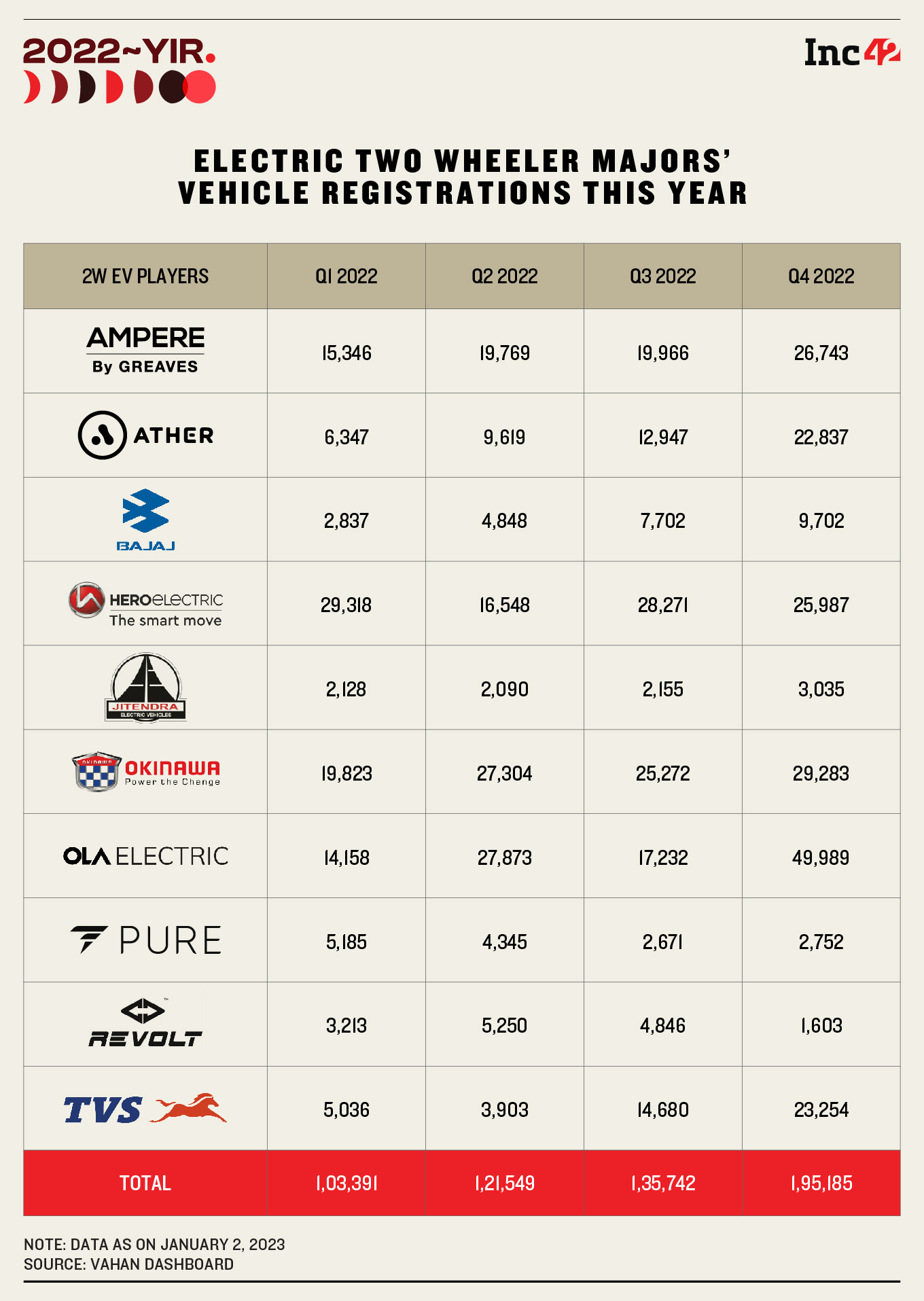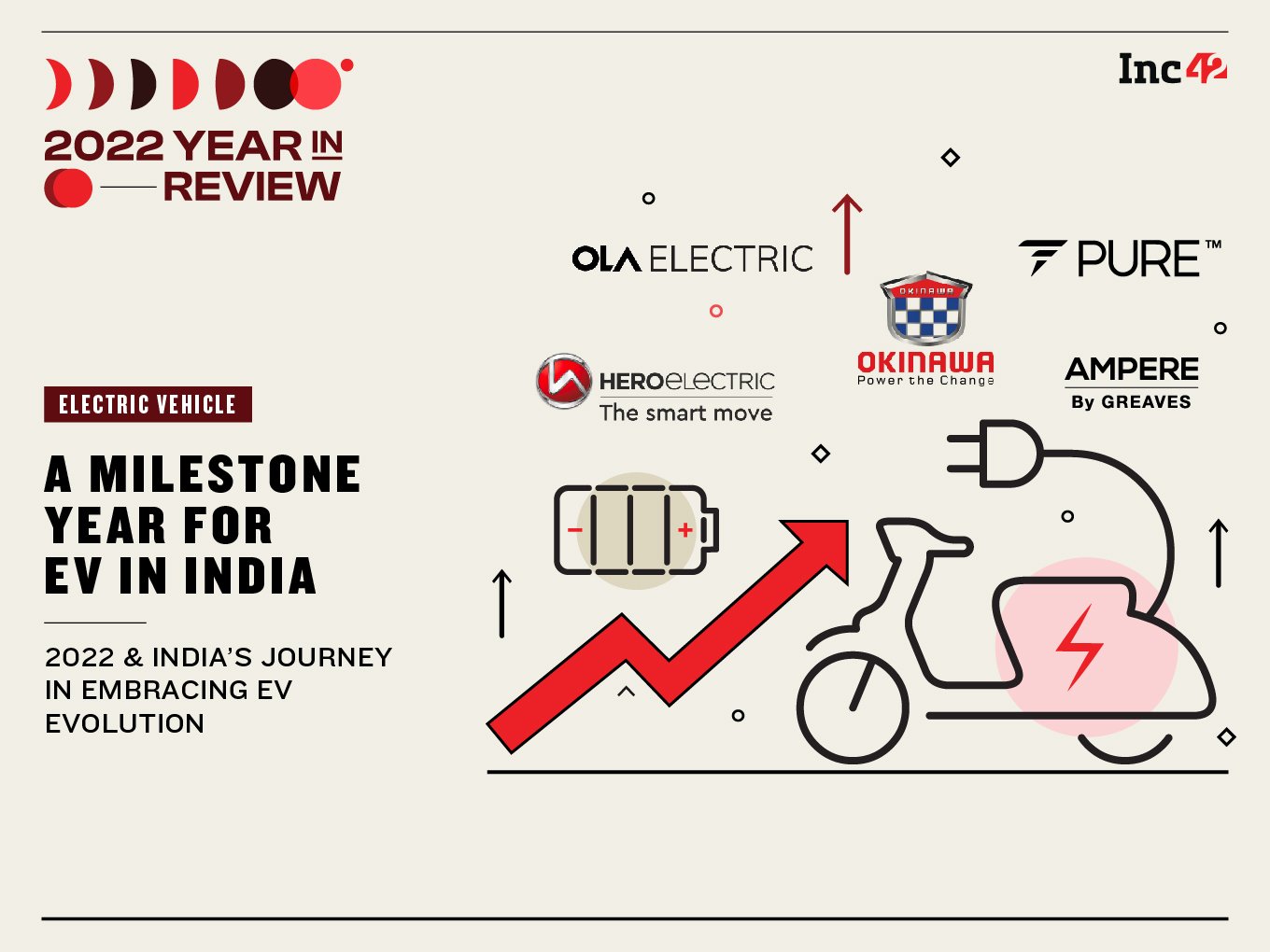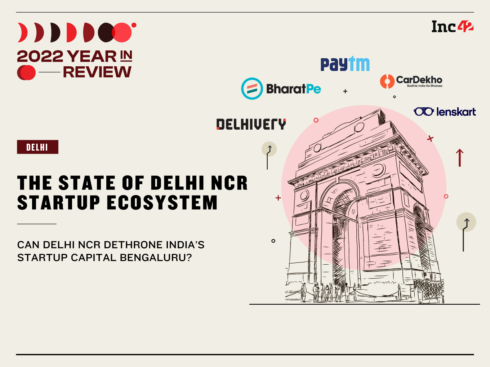SUMMARY
The total number of electric vehicles registered in 2022 stood at 10 Lakh units, up 300% from the 3.2 Lakh units registered in 2021
The Indian government claims to have already subsidised more than 7.4 Lakh EVs to the tune of INR 3,200 Cr until December 7, 2022
According to the data on Vahan website, Ola Electric registered 1,09,252 units of electric vehicles in 2022, followed by Okinawa at 1,01,682 vehicles
The year 2022 remained crucial for the growth of India’s electric vehicle (EV) market. While the space witnessed a significant spike in the adoption of electric three-wheelers for commercial use, battery-powered two-wheelers, primarily, led the growth of the nation’s EV sector. It is pertinent to mention here that the Indian government, with its policies and incentive schemes, too, played a key role in giving a much-needed boost to this burgeoning domain.
Download Annual Funding Report 2022While the year saw a 4X rise in the registration of electric two-wheelers to 6.2 Lakh units in 2022 from just 1.5 Lakh units in 2021, the total number of electric vehicles registered in 2022 stood at 10 Lakh units, up 300% from the 3.2 Lakh units registered in 2021.
However, this growth has not been smooth, as, during the year, the original equipment manufacturers (OEMs) got an earful due the use of substandard quality of batteries in the vehicles. As a result, several incidents of electric scooter fires in various parts of the country got a lot of attention during the year.
Although many say such issues are common when an industry is in its nascent stages, others are of the opinion that standardised quality checks and a focus on R&D, which were visibly lacking in most EV startups in India, should be mandatory for companies across industries, new or old.
Government’s EV Push: A Shot In The Arm
Even though it’s been more than five years that the Indian government is trying to reduce vehicle emissions through the electrification of vehicles, it is only recently that the Centre’s efforts have started to show some green shoots.
Also, one cannot ignore the role of government-led subsidies, OEM- and consumer-focused policies, and EV targets set by various state governments in the overall evolution of the sector.
It is pertinent to note that under phase-II of the Faster Adoption and Manufacturing of (Hybrid &) Electric Vehicles (FAME), the Indian government claims to have already subsidised more than 7.4 Lakh EVs to the tune of INR 3,200 Cr until December 7, 2022.
FAME-II was launched in 2019 with an outlay of INR 10,000 Cr to boost the demand for EVs by providing upfront subsidies to the end users and extending support towards the creation of a charging infrastructure. The government’s FAME-II scheme aims to incentivise 10 Lakh electric two-wheelers, along with 7,090 ebuses, and 5 Lakh electric three-wheelers, among others, to boost their adoption.
Besides, to spur the demand in this space, the government has introduced a Production Linked Incentive (PLI) scheme, with an estimated outlay of INR 18,100 Cr, for the manufacturing of Advance Chemistry Cell (ACC) in India. With this scheme, the government aims to bring down the prices of EV batteries and, in turn, electric vehicles.
In 2022, electric two-wheeler major Ola Electric, Rajesh Exports and Hyundai Global Motors Company won incentives for 20-gigawatt hours (GWh) of battery storage capacity.
The government’s draft battery-swapping policy introduced in the mid of 2022 is also expected to drive the EV adoption. However, India needs to pick up pace in the battery charging and swapping space.
Meanwhile, the impact of the government’s subsidy and incentive schemes has been such that the country’s EV market has seen the number of two-wheeler players grow from just 48 in 2021 to 100 in 2022, as per Vahan.
Some of the players who joined the EV race in 2022 include Micelio Motors, Hop Electric Mobility, Lectrix, and Okaya EV.
Despite a significant rise in the demand of electric two-wheelers, the growth trend largely remained volatile throughout the year due to multiple issues and regulatory uncertainties. However, players like Ather Energy, Bajaj, and TVS continued to witness a steady rise in EV sales during the year.

EV OEMs Receive Flak Over Quality Issues
A sudden increase in the momentum of EV adoption has led to EV players compromising with the quality of batteries that are used to power such vehicles. Quality issues with EV batteries came to the fore when a panel of experts investigated the cases of electric vehicles catching fire last year.
In the investigation, experts found several defects in EV batteries, including the designs of the battery packs and modules. However, by then it was too late, as numerous end users had already been impacted due to substandard quality of batteries in their vehicles. This also attracted a lot of public criticism, and many questions were raised on the reliability of such vehicles.
While the blame has been repeatedly put on the batteries and cells imported from China, it must be noted that the issue lies in the inferior quality of cells and batteries being imported by some Indian EV OEMs.
Following the fire incidents last year, several experts, who spoke with Inc42, said that EV OEMs should focus more on testing cells and batteries keeping the Indian user and the country’s climate in mind. In a bid to make the entire process a bit cheaper, EV OEMs often compromise on testing and cell quality, experts opined.
The issue caught the government’s attention and led to tightened battery testing rules, with the Bureau of Indian Standards (BIS) bringing certain performance standards for EV batteries in India. In October 2022, new/reformed safety standards, AIS 156 and AIS 038 Rev.2, came into play. These standards include additional safety requirements related to EV battery cells, Battery Management System (BMS), battery pack design, thermal propagation, on-board charger, and more.
Dev Arora, the cofounder and CEO of ALT Mobility, said as the OEMs are in the process of complying with the new testing norms, there have been delays and a slowdown in the supply of orders.
“We anticipate that in January and February most OEMs will have completed the required compliances and expanded their facilities to improve the production output,” Arora said.
Meanwhile, the government has also tightened regulations around localisation norms. It has decided to penalise and exclude the electric two-wheeler OEMs who were enjoying the perks of FAME-II subsidy without adhering to the localisation norms of manufacturing components in India.
Subsidies to Hero Electric and Okinawa have already been quashed. While EV adoption is set to rise, the changes in FAME are also likely to have a near-term impact on this growth, experts believe
2023 And The Road Ahead
Vinkesh Gulati, the chairman of the Federation of Automobile Dealers Associations (FADA), said that the two-wheeler segment is in a very complicated stage right now.
“In 2023, there will surely be an increase in the EV demand, but the initial two or three months will be challenging until the FAME issues are resolved,” Gulati said.
He, however, said that the leading two-wheeler EV player Ola Electric has started to slowly and steadily understand the market. “Its strategic step to launch experience centres will give its sales a massive boost because in India face-to-face presence is extremely important,” Gulati said.
According to the data on Vahan website, Ola Electric registered 1,09,252 units of electric vehicles in 2022, followed by Okinawa at 1,01,682 vehicles.
With changes in the regulation, some impacts could be seen in the first quarter of 2023, but things will normalise as the calendar year will come to an end, believes Pankaj Gupta, the CEO of Mufin Green Finance.
“The growth of the EV sector will be propelled by sub-segments such as battery tech startups (battery as a service, battery swapping), EV financing, motor controllers and vehicle intelligence services, EVs powered by hydrogen cells, and solar powered EVs,” Gupta added.
Meanwhile, despite the near-term challenges, investors look impressed with the growth story of the country’s EV space. “We’ve been having positive conversations with multiple funds within and outside India, which are actively building a thesis around the electric vehicle segment across multiple plays including manufacturing, battery technology, financing/leasing, distribution, and ecosystem plays. By next year, I am optimistic about seeing an increase in investment bets across the value chain,” ALT Mobility’s Arora said.
According to a study by Deloitte, the overall EV sales are likely to jump to 16,44,000 units by FY25 and further increase to 1,53,31,000 units by 2030, which would be majorly dominated by two-wheelers. Experts anticipate EV sales to rise 3X to 4X in 2023 compared to 2022.
Download Annual Funding Report 2022


























